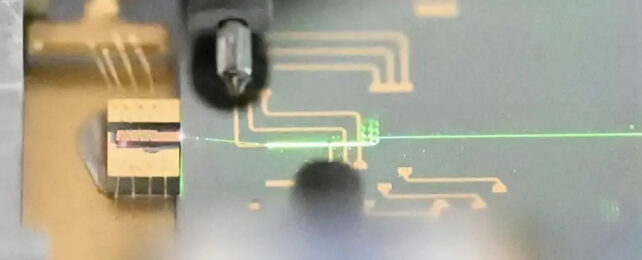To accurately measure the Universe on the smallest scales, you need a laser with the perfect mix of power and precision. Most that are capable of this task are bulky, expensive, and chew through power.
An innovation by scientists at the California Institute of Technology (Caltech) could change that, delivering a laser capable of producing ultrashort pulses that can fit on a fingertip.
These lasers can potentially be used for everything from medical imaging to atomic clocks to navigating between places without the aid of GPS. In any situation where super-speed laser pulses are required, these incredibly compact instruments could help.
The tiny size is by no means a gimmick: putting this tech into a more compact form opens it up to a wealth of new uses, because it becomes so portable and can be fitted into other gadgets that will fit into pockets and bags.
"Our goal is to revolutionize the field of ultra-fast photonics by transforming large lab-based systems into chip-sized ones that can be mass produced and field deployed," says physicist Qiushi Guo, from Caltech and the City University of New York.
"Not only do we want to make things smaller, but we also want to ensure that these ultra-fast chip-sized lasers deliver satisfactory performances."
These types of lasers are known as mode-lock lasers or MLLs, which create extremely quick laser pulses (because different laser frequencies and phases are 'locked' together) – we're talking in the region of femtoseconds, or quadrillionths of a second.
Quicker laser pulses mean observations can be made at smaller scales, and of objects that are moving faster, such as atoms in a molecule. However, right now the best and most powerful MLLs are table-sized, and need a lot of energy to run.
To create an MLL on such a small chip, the team used a material called thin-film lithium niobate (TFLN), which enables the use of external radio frequency electrical signals to control laser pulses in a precise way. The material was combined with a special type of laser-friendly semiconductor to produce the super-small laser.
The results were impressive, capable of delivering a 4.3 picosecond (that's trillionths of a second) long pulse in near-infrared, with a peak power of around half a watt.
What's more, the finished laser was impressively versatile in terms of how it can be tuned, as well as operated in a way that suggests it can be incorporated into portable, hand-held devices. The next stage is figuring out how that can be made possible.
Lasers can be used as both instruments for taking measurements, and as ways of affecting the surrounding environment – and the researchers behind the new miniaturization process see a bright future for their creation.
"This achievement paves the way for eventually using cell phones to diagnose eye diseases or analyzing food and environments for things like E. coli and dangerous viruses," says Guo.
"It could also enable futuristic chip-scale atomic clocks, which allows navigation when GPS is compromised or unavailable."
The research has been published in Science.
